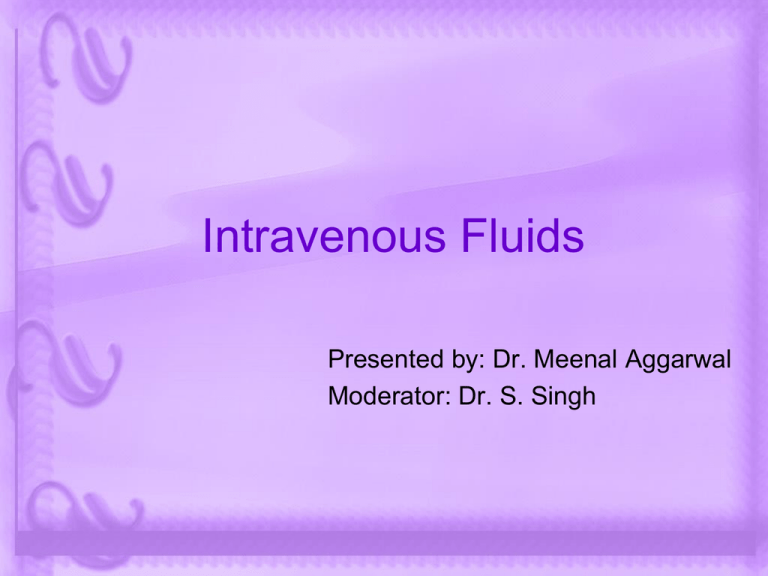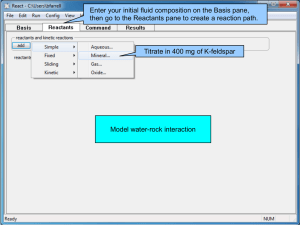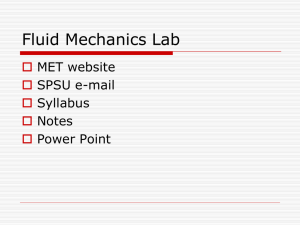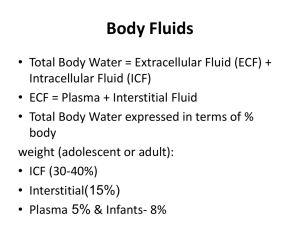Intravenous Fluids
advertisement

Intravenous Fluids Presented by: Dr. Meenal Aggarwal Moderator: Dr. S. Singh Basic Physiology • Total body water: Pre mature infant : 80% of lean B.W. Term infant: 70 – 75% Adult male : 60% (more muscle) Adult female : 50% (more fat) TBW(60) : ECF (20)(plasma + interstitial fluid) + ICF (40) 40 40 15 5 ICF Plasma Interstitial fluid Rest of B.W. • In children : higher ECF (contributes to higher B.W.) • T.B.W decreases with age (mainly d/t loss in ICF) • Composition of body fluids: ICF : K+ , Mg2+ Organic phosphate esters (ATP, Creatine phosphate, phospholipids) ECF : Na+ , Cl- , HCO3• Compartments are separated by semi-permeable membrane • Water freely passes through it and maintains an osmotic equilibrium • Daily fluid requirement: Urine output + insensible losses (700ml) Fluid Homeostasis in Body Volume regulation Important for adequate tissue perfusion Effective circulating vol Sensed by Baroreceptors Carotid sinus, aortic arch Afferent glomerular arterioles Atria, ventricles Act via Sympathetic nervous system ReninAngio-aldo Natriureic hormones (ANP, BNP) Argenine vasopressin Fluid Homeostasis in Body cont… Osmoregulation Essential for cell function Plasma osmolarity Sensed by Osmoreceptors In hypothalamus (paraventricular, supraoptic nuclei) Act via AVP Thirst Normal Plasma Osmolality = 2 X [Na+] + [BUN/2.8] + [Glu/18] Normal value = 275-295 mosm/Kg Fluid Balance in Perioperative Period • Goal: Euvolemia, normal oxygen carrying capacity and normal electrolyte distribution • Challenges: because of: Fasting status Losses (bleeding, evaporation, 3rd space losses) Effects of neuraxial anesthesia (sympatholysis) Ineffective thirst (d/t diminished alertness after GA/ sedation) Assessment of Fluid Balance • Preop History: Medical illness, preop vol status • Surgery/ Intervention: Type of surgery, blood loss/ 3rd space • Anaesthesia: Type, duration, Fluid replacement given, BT, Type of monitoring, intra-op vital trends • Current clinical condition: GPE: Weight, Skin and tongue, sensorium, pulse, BP Urine output : Should be >0.5-1ml/kg/hr Monitoring: Pleth, IBP, C.O. measurement, CVP, PCWP, TEE Lab: S.urea, S.creat, urinary Na, ABG (pH, lactate, Hct), VBG Intra Venous Fluids NS, 3% S, N/2 S Unbalanced D5, D10, D 25 Crystalloids Ringer Lactate Balanced Isolyte P I V Fluids Gelatins Dextrans Colloids Starches (HES) Human Albumin Normal Saline (0.9% NaCl) • Composition : Na+ 154 meq/L, Cl- 154 meq/L • Osmolarity: 308 mOsm/L (Isotonic), pH : 6.0 • Distributed mainly in ECF, so very useful in hypovolemic shock • Only 25% of the total fluid given remains intravascularly, 3-4 times volume of fluid lost is required for replenishment • Indication: Salt and water deplation as in diarrhoea, vomiting, excessive sweating Tt of alkalosis (e.g. vomiting) with dehydration, May induce non anion gap hyperchloremic metabolic acidosis (as high chloride l/t dec plasma HCO3- content) Normal Saline (0.9% NaCl) cont.. Hypovolemic shock Hyponatremia Initial fluid therapy in DKA Fluid challenge in pre-renal ARF Irrigation fluid Hypertonic Saline (3-7.5%): used in therapy of severe symptomatic hyponatremia, for resuscitation in patients of hypovolemic shock Caution: should be administered slowly, preferably through central venous catheter because can l/t hemolysis Normal Saline (0.9% NaCl) cont.. • Contraindication: Cautious use in HTN or preeclamptic patients, CHF pts, renal ds, cirrhosis If dehydration is preset along with hypokalemia (need to add K+ or else NS alone will aggravate K+ deficiency) Used cautiously in patients with renal derangements (chloride l/t decreased renal blood flow) Note: As it can l/t metabolic acidosis, should not be mistakenly interpreted as lactic acidosis in cases of impaired circulation 5% Dextrose • Composition : Glucose 50 g/L (or 25 g/vac) • Osmolarity: 252 mOsm/L (hypotonic), pH : 4.5 • Only 8% of the total fluid given remains intravascularly (glucose gets metabolised when enters body, so free water) best for correcting intracellular dehydration • Provides 170 Kcal/ L • Indications: Tt of dehydration d/t inadequate water intake/ excessive water loss To provide calories Pre- and post-op replacement fluid 5% Dextrose cont… Tt and prevention of ketosis in starvation/ diarrhoea/ vomiting Correction of hypernatremia ( with frusemide) • Contraindications: Cerebral edema/ Neurosurgical procedures/ Acute ischemic stroke Hypovolemic shock (also osmotic diuresis) Careful administration during hypernatremia Along with blood transfusion (hemolysis, clumping) Severe hyperglycemia/ uncontrolled DM Ringer’s Lactate • Composition : Na= 130mEq, K= 4mEq, Ca= 3mEq, Cl= 109mEq, lactate= 28 mEq per litre of RL • Osmolarity: 274 mOsm/L (hypotonic), pH : 6.5 • Most physiological fluid (can be given in large quantities without risk of electrolyte imbalance) • Lactate is converted to HCO3 in the liver (correction of metabolic acidosis) • Indications: Tt of severe hypovolemia rapidly with large fluid volume Diarrhoea induced hypovolemia with hypokalemic metabolic acidosis Ringer’s Lactate cont… Postoperative fluid replacement In DKA, RL provides free water so corrects metabolic acidosis, also gives K (controvertial regarding lactate) • Contraindications: Liver ds, severe hypoxia and shock (impaired lactate metabolism) In severe CHF with lactic acidosis Addison’s disease Even in severe metabolic acidosis (impaired lactate conversion) In vomiting or NG aspiration (metabolic alkalosis, RL worsens) Along with BT (Ca combines with citrate, forms clots), binds drugs (thiopentone, amphotericin, ampicillin, EACA) Isolyte-P • Composition : Glu= 50 g, Na= 25mEq, K= 20mEq, Cl= 22mEq, acetate= 23 mEq HPO4= 3 mEq, Mg= 3mEq per litre • Designed to suit maintenance requirement of children (need more water) • Can be used In adults where more water required (hypernatremia) • Indications: Maintenance fluid in children and infants Excessive water loss/ inability to conc urine (DI) • C/I: Hyponatremia, hypovolemic shock (less Na, More K, glucosuria) Renal failure Plasma-lyte • Composition : Na= 140 mEq, K= 5 mEq, Cl= 98 mEq, acetate= 27 mmol, gluconate 23 mmol, Mg= 1.5 mmol per litre • Produces a metabolic alkalinizing effect (acetate and gluconate metabolize to CO2 and H2O using H+ ions) • Indications: Fluid replacement For alkalinization • Caution: CHF, Edema with Na retention Renal failure and metabolic alkalosis Sterofundin • Composition : Na= 145 mEq, K= 4 mEq, Cl= 127 mEq, Ca= 2.5 mmol, acetate= 24 mmol, Malate 5 mmol, Mg= 1 mmol per litre • pH: 5.1-5.9, osmolarity= 309 mosm/L • Indications: Fluid replacement in isotonic dehydration For alkalinization • Caution: CHF, Edema with Na retention Renal failure/ hyperkalemia and metabolic alkalosis Hydroxyethyl starches • Modified natural polysaccharides similar to glycogen • To delay α-amylase breakdown: natural starches are substituted with hydroxyethyl groups • Classified into: high (hexastarch), medium (pentastarch) and low (tetrastarch) substitution. High Molar substitution delays degradation • Plasma expanding effect depends on the concentration solution • Advantages: High hemodilutional capacity Vascular resistance is reduced by lowering blood viscosity (beneficially influence tissue perfusion) Hydroxyethyl starches cont… • Disadvantages: Decrease levels of vWF and factor VIII activity, impair platelet function, induce platelet damage (apparent when >1500ml given within 24hrs) Renal dysfunction (hyperviscosity of urine in dehydrated pts) Pruritis may occur d/t extravascular deposition of starch Allergic reactions (although lowest c/f other colloids) Clearance takes over several weeks (although oncotic activity is lost after 24hrs) Gelatins (Haemaccel) • Produced by degradation of bovine collagen and chemical modifications • Commercially available preparations: 3.5%-5.5% • Adv: Average molecular weight: 30-35 kD, small molecular weight, rapidly cleared from the bloodstream by glomerular filtration (80%) Volume effect 70-100% Do not accumulate in the body, have no dose limitations, almost no adverse effects on the kidneys Gelatins cont… • Disadv: Hemostasis could be impaired (interference with coagulation factors, disturbance in the quality of fibrin polymerization) Bovine origin (hypothetical potential of transmitting prion diseases) Most frequent incidence of allergic reactions (6 times c/f HES) Cleared rapidly so repeated infusions of gelatins are necessary to maintain adequate blood volume Dextrans • Biosynthesized from sucrose by the bacterium Leuconostoc mesenteroides • Dextran 40 and dextran 70 (molecular weights of 40 and 70 kD) • Adv: Molecules less than 50 kD are rapidly eliminated by the kidneys Decreases blood viscosity, improved microcirculatory blood and tissue perfusion Used by vascular and plastic surgeons to assist in keeping microvascular anastomosis patent Dextran 70: generally preferred for volume expansion Dextran 40: improve blood flow in the microcirculation Dextrans cont… • Disadv: Induces a dose-dependent hyperfibrinolysis, decreased levels of vWF and associated factor VIII (VIII:c) activity, Max daily dosing: 1.5g dextran/ kg body wt Coat red cells (interfere with cross matching, inc ESR) Impaired renal function (tubular obstruction, swelling, and vacuolization of tubular cells due to hyperviscous urine) Severe anaphylactic reactions (Prevention: dextran 1 (Promit), a low-molecular-weight hapten, administered few minutes before any dextran infusion) Human Albumin • Purified from pooled human plasma • Commercially available as a 5% (iso-oncotic), 20% & 25% (hyperoncotic) solution • Heated and sterilized by ultrafiltration, so risk of bacterial or viral disease transmission eliminated • Functions of albumin: maintaining the plasma oncotic pressure, transport protein, plasma buffer • Predictor of mortality risk in patients with acute and chronic illness (for each 2.5 g/L decrement in serum albumin concentration the risk of death increases by 24% to 56%) • 5% albumin: 70% effective, effect lost in 12 hrs Human Albumin cont… • Uses: Acute restoration of an effective circulating volume due to hemorrhage Acute management of burns Hypoproteinemia • Disadv: High cost Even detrimental in burns, hypoproteinemic pts. Allergic reactions (equal to HES) Colloid vs Crystalloid • For crystalloids: inexpensive, adverse effects are rare or absent, no renal impairment, minimal interaction with coagulation other than dilution, no tissue accumulation, no allergic reactions • For colloids: much better volume-expanding properties, minor edema formation, improved microcirculation • When compared neither type of fluid provided a survival benefit • So in patient with hypovolemia d/t dehydration (uniform loss of ECF), crystalloids are benefecial • In patients with hypovolemia secondary to hypoalbuminemia, colloids benefit the patient more. Balanced vs Unbalanced Solutions • Large volume resuscitation with normal saline causes hyperchloremic metabolic acidosis (l/t organ hypoperfusion, increased morbidity, especially gastrointestinal, neurologic, renal damage, blood loss) • Buffered formulations (RL, Isolyte P) maintain a higher plasma pH and less chloride load, fewer incidences of hyperchloremic metabolic acidosis, low concentration electrolytes l/t reduction in postoperative morbidity. Balanced crystalloid solutions are preferred in the perioperative period • Colloids suspended in balanced solutions now available, are better Maintenance Fluid therapy • Normal ongoing losses in 70 kg man: 2100-2500ml/day • Fluid to be given calculated acc to Holliday & Segar formula”4-2-1” • Best maintenance fluid: balanced isotonic crystalloid (RL) untill the patient is NPO • Best estimation of fluid requirement is made by weighing the patient daily • Neuraxial anesthesia: Preloading with 250-200ml fluid appears to temporarily increase preload and C.O. without consistently increasing arterial B.P. or preventing hypotension. Replacement Fluid therapy • Bleeding/ 3rd space loss/ Evaporation/ Sweating • Assessment: Estimate/ measure + Clinical examination + laboratory data • Type of fluid depends on the type of fluid lost or any electrolyte imbalance already present • Rate of administration: Arbitrary, depends on severity of deficit (diff in case of hyper/hypo Na) Post Operative Fluid • Aim: BP > 100/70mm Hg, Pulse <120, Urine 30-50ml/hr, normal temperature, respiration, sensorium • When to give: Usually for minor surgeries (no gut handling) started orally 4-6 hrs postop. In Major surgeries( no gut handling e.g. THR/ cardiac) 2448 hrs of IV fluids When intestinal resection: needs few days of IV fluids Post Operative Fluid cont… • Routine postop orders for fluids for 3 days: First 24 hrs: 2litre D5 or 1.5litre D5 + 500ml NS (except neurosurgical patients, major surgeries) 2nd post op day: 2 litre D5 + 1litre NS 3rd postop day: Same + 40-60 mEq KCl Modified according to individual case Preferred fluid therapy • In Vomiting: (Hypovol, HypoK, HypoCl, Meta alk) NS • In Diarrhoea: (Hypovol, HypoNa, HypoK, HyperCl, Meta Acid) RL & NS • CHF: Oedema d/t salt & water retention (HypoNa) Avoid Na rich fluids like RL & NS, Don’t chase urine output • ARDS: Pulmonary edema d/t inc capillary permeability, Keep dry, maintain balance b/w diuretics and fluid to keep MAP >75-80mmHg • In Neurological ds: maintain euvolemia (no hypotension) caution during mannitol, avoid hypotonic fluids and hyperglycemia (avoid D5), RL appropriate for small vol infusion, NS is ideal • DKA: Glycosuria, osmotic diuresis, meta acid, K+ def, Mg & P def. Preferred fluid therapy cont… • DKA cont…: Initial therapy NS, If no hypotension and good urine output RL can be given, KCL can be added here, Further can switch to 0.45 Saline (acc to Na conc), once sugars below 250mg/dl D5 is to be used. • In Renal Disease: Fluid restriction (Urine output + 500ml), in edematous pt so not chase the urine, salt restriction 2-3g/d, Avoid hyperkalemia (RL). • In nephrotic NS prefered • Pre-renal ARF: NS prefered • In CRF: 5D or 10D prefered, limit fluid admn THANK YOU





